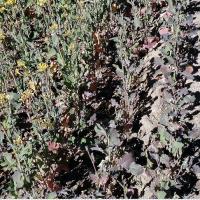Diagnosing glyphosate damage in canola
Glyphosate is a systemic knockdown herbicide that is used extensively for brown fallow, summer weed or pre-seeding weed control, or selective weed control in glyphosate resistant crops.
What to look for
- Limp discoloured plants that may slowly die.
- Direct spray damage is uniformly distributed but varies with spray coverage on overlaps or boom turns.
- Spray drift damage is worse near the source.
Paddock
- Vegetative plants develop yellow-red-purple leaves and may slowly die.
- Emerging leaves are distorted and discoloured and leaf blades become cupped and crinkly.
- The leaf blade develops blotchy purple-yellow interveinal discolouration that is initially worse towards leaf margins, and uniformly purple undersides.
- Petioles become increasingly twisted as symptoms worsen.
- Spray drift after head emergence causes leaf purpling, and death of the flowering spike. Plants may repeatedly send up flowering side branches that then slowly die.
Plant
What else could it be
| Condition | Similarities | Differences |
|---|---|---|
| Diagnosing group B herbicide damage in canola | Discoloured distorted young plants with distorted or dying growing point. Plant death or multiple growing points. Flowering spike death. | Group B herbicides are much more damaging in trace amounts and as soil residues; young plants have more yellow than purple colours; surviving plants after bud formation have shortened internodes giving pods a bunchy appearance. |
| Diagnosing calcium deficiency in canola | Flowering head death | No leaf symptoms and plants usually recover |
See also
Further information
Page last updated: Tuesday, 27 May 2014 - 5:12pm





